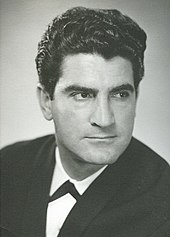| Music of Iran | ||||
| General topics | ||||
|---|---|---|---|---|
| Genres | ||||
| Specific forms | ||||
|
||||
| Media and performance | ||||
|
||||
| Nationalistic and patriotic songs | ||||
|
||||
Iranian jazz refers to jazz music composed by Iranian musicians, sometimes combined with traditional Iranian elements.
History
Early years

Jazz music emerged in Iran along with the development of western influences into the pop music. One of the pioneers of jazz music in Iran was Alfred Lazaryan, a little-known singer and dancer whose first recorded song made a hit on the Iranian national radio. [4] However, Lazaryan soon gave up singing. [4] Viguen Derderian, a celebrated pop and jazz artist popularly known simply as "Viguen", began his career in the early 1950s. [3] Viguen's first song, Moonlight, which was released in 1954, [1] was also an instant hit on the radio, [3] and is considered to have marked a turning point in Iran's western-influenced music. [1] Viguen created some of Iran's most memorable songs, including collaborations with Delkash, [3] and was known as Iran's " Sultan of Jazz". [1] [2] [3] [5]
After the 1979 Revolution
A music group named Ejazz performed the first officially sanctioned jazz music concert in post-revolutionary Iran. [6] They produced jazz fusion, incorporating elements from the indigenous classical music. [6]
Rana Farhan, an Iranian jazz and blues singer living in New York, [7] combines classical Persian poetry with modern jazz and blues. [8] She has established a model to the jazz fusion project that she continues to incorporate in her work. Her best-known work, Drunk With Love, is based on a poem by prominent 13th-century Persian poet Rumi. [7]
Bomrani, one of the first country blues bands in post-revolutionary Iran, was founded in 2008, as part of a new wave of influences onto the music stages of Tehran. [9] Pallett, a similarly successful band that was formed in 2009, [10] composes jazz fusion of clarinet, cello, and double bass. [9] They have garnered a huge following in Iran, and have also performed abroad. [11]
Samples
See also
References
- ^ a b c d Armbrust, Walter (2000). Mass Mediations: New Approaches to Popular Culture in the Middle East and Beyond. University of California Press. p. 70. ISBN 9780520219267.
- ^ a b Saba, Sadeq (October 27, 2003). "Iranian pop legend dies at 74". BBC News. BBC News. Retrieved August 18, 2014.
- ^ a b c d e Saba, Sadeq (November 26, 2003). "Obituary: Vigen Derderian". The Guardian. London. Retrieved March 24, 2013.
- ^ a b "گفتگوئی با آلفرد لازاریان" [An Interview with Alfred Lazaryan]. Sepid-o-Siah magazine (in Persian) (956 ed.). Tehran, Iran. February 9, 1972.
- ^ Zinder, Jac (March 19, 1992). "The King of Persian Pop: Never a Dull Nouruz". Los Angeles Times.
- ^ a b "اولین کنسرت جز ایرانیزه شده با سبک تلفیقی بعد از انقلاب در ایران" [The First Iranized Jazz Concert with a Fusion Style After the Revolution in Iran]. Musicema (in Persian). November 8, 2010.
- ^ a b Curiel, Jonathan (September 24, 2013). "Rana Farhan Sings the 'Persian Blues'". KQED Arts. Retrieved March 7, 2015.
- ^ Smith, Emily Esfahani (August 30, 2011). "Persian Poetry Gets the Blues". The Wall Street Journal. Retrieved April 5, 2018.
- ^ a b "Iranian blues and jazz bands find fans in Tehran". Reuters. November 13, 2014.
- ^ "Pallett Releases 'Endless Ending'". Financial Tribune. March 1, 2017.
- ^ "Iranians love their klezmer". Public Radio International. February 26, 2016.
